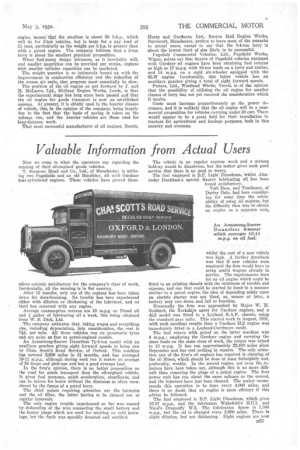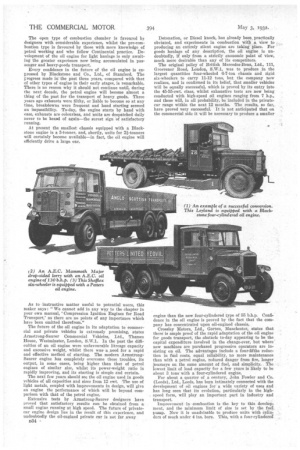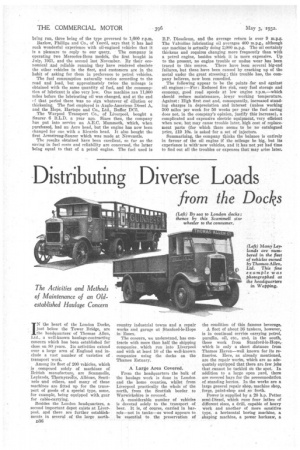Valuable Information from Actual Users
Page 97

Page 96

Page 98

If you've noticed an error in this article please click here to report it so we can fix it.
As to instructive matter useful to potential users, this maker says: We cannot add in any way to the chapter in your own manual, 'Compression Ignition Engines for Road Transport,' as there are no points of any importance which have been omitted therefrom."
The future of the oil engine in its adaptation to commercial and private vehicles is extremely promising, states Armstrong-Saurer Commercial Vehicles, Ltd., Thames House, Westminster, London, S.W.1. In the past the difficulties of an oil engine were unfavourable litreage capacity and excessive weight, whilst there was. a.need for a rapid and effective method of starting. The modern ArmstrongSaurer engine has completely overcome these troubles, its output, in some cases, being higher than that of petrol engines of similar size, whilst its power-weight ratio is rapidly improving, and its starting is simple and certain.
The next few years should see the oil engine used in goods vehicles of all capacities and sizes from 12 cwt. The use of light metals, coupled with improvements in design, will give an engine the performance of which will be beyond comparison with that of the petrol engine.
Extensive tests by Armstrong-Saurer designers have proved that satisfactory results can be obtained from a small engine running at high speed. The future of privatecar engine design lies in the result of this experience, and undoubtedly the oil-engined private car is not far away
DS4 ;
engine than the new four-cylindered type of 55 b.h.p. Confidence in the oil engine is proved by the fact that the company has concentrated upon oil-engined chassis.
Crossley Motors Ltd., Gorton, Manchester, states that there is ample proof of the rapid adaptation of the oil engine for goods transport, the obstacle to-day appearing to be the capital expenditure involved in the change-over, but where new machines are purchased progressive operators are insisting on oil. The advantages include a four-fifths reduction in fuel costs, equal reliability, no more maintenance than with a petrol engine, reduced danger from fire, longer journeys on the same amonnt of fuel, and simplicity. The lowest limit of load capacity for a few years is likely to be about 3 tons with a four-cylindered engine.
For about a quarter of a century, John Fowler and Co. (Leeds), Ltd., Leeds, has been intimately connected with the development of oil engines for a wide variety of uses and has long seen that its evolution, particularly in the high, speed form, will play an important part in industry and transport.
Improvement in combustion is the key to this development, and the minimum limit of size is set by the fuel pump. Now it is unadvisable to produce units with cylinders of much under 4 ins. bore. This, with a four-eylindemi selves entirely satisfactory for the company's class of work. Incidentally, all the running is in flat country.
After 12 months, only one of the engines has been taken down for decarbonizing. No trouble has been experienced either with dilution or thickening of the lubricant, and no fault has occurred with any engine.
Average consumption returns are 15 m.p.g. on Diesel oil and gallon of lubricating oil a week, this being obtained from W. B. Dick, Ltd.
The company estimates that, taking wages and everything else, including depreciation, into consideration, the cost la 7id. per mile. All three vehicles run on pneumatic tyres and are quite as fast as petrol-engined models.
An ArmstrongsSaurer Dauntless 71-8-ton model with an auxiliary gearbox giving eight forward speeds is being run by Chas. Scott's Road Service, of Oxford. This machine has covered 6,600 miles in 34 months, and has averaged 10-11 m.p.g., although during each run it snakes an average of 20 drops and pick-ups and has a good average load.
In the firm's opinion, there is no better proposition on the road for goods transport than the oil-engined vehicle. It gives fuel economy, quick acceleration, cleanliness, and can be driven for hours without the dizziness so often occasioned by the fumes of a petrol lorry.
The chief points requiring attention are the batteries and the oil filter, the latter having to be cleaned out at regular interval& The only engine trouble experienced so far was caused by dislocation of the wire connecting the small battery and the heater plugs which are used for starting on cold mornings, but the fault was speedily detected and rectified.
for an oil engine which could be fitted to an existing chassis with the minimum of trouble and expense, and one that could be started by hand in a manner similar to a petrol engine, the idea of depending solely upon an electric starter was not liked, as, sooner or later, a battery may run down and fail to function. Eventually the firm was approached by Major W. Al Goddard, the Yorkshire agent for Gardner engines, and a 4112 model was fitted to a Leyland R.A.V. chassis, using the standard gear ratio. This started work in August, 1931, with such excellent results than a Gardner 5L2 engine was immediately fitted to a Leyland-Carrimore outfit.
The fuel return with petrol on the latter machine was 4 m.p.g.; employing the Gardner. engine and carrying the same loads on the same class of work, the return was raised to 13 m.p.g. It has run approximately 22,400 miles since September and has cost nothing in repairs. The only attention any of the ,firm's oil engines has required is cleaning of the oil filters, which should be done at least fortnightly and, preferably, weekly. In the second engine, not even the injectors have been taken out, although this is no more difficult than removing the plugs of a petrol engine. The first power unit has run about the same mileage as the second, and the injectors have just been cleaned. The maker recommends this operation to be done every 4,000 miles, and there is no doubt that an engine is more efficient if this advice be followed.
The fuel employed is D.P. Light Diesoleum, which gives 16-17 m.p.g., and the lubricants Wakefield's H.C.I. and Nicol' s Dragonfly W.2. The lubrication figure is 1,000 m.p.g.,' but the oil is changed every 2,000 miles. There is slight diltition, but not thickening. Eight engines are now
being run, three being of the type governed to 1,600 r.p.m. Barlow, Phillips and Co., of Yeovil, says that it has had such wonderful experience with oil-engined vehicles that it
is a pleasure to .reply to our query. The company is operating two Mercedes-Benz 'models, the first bought in July, 1931, and the second last November. By their economical and reliable running they have rendered obsolete the other vehicles in the fleet, and customers are in the habit of asking for them in preference to petrol vehicles.
The fuel consumption naturally varies according to the road and load, but approximately twice the mileage is obtained with the same quantity of fuel, and the consumption of lubricant is also very low. One machine ran 11,000 miles before the lubricating oil was changed, and at the end ef that period there Was no sign whatever of dilution or thickening. The fuel employed is Anglo-American Diesel A, and the Hope, Hartope and Co., Ltd., Buffer DC5.
The Warpool Transport Co., of Liverpool, bought a Saurer 8 B.L.D. a year ago. Since then, the company has put into service an A.E.C. Mammoth, which, when purchased, had an Acre head, but the engine has now been changed for one with a Ricardo head. It also bought the first Armstrong-Saurer which was made at Newcastle.
The results obtained have been excellent, so far as the saving in fuel costs and reliability are concerned, the latter being equal to that of a petrol engine. The fuel used is
B.P. Diesoleum, and the average return is over 9 m.p.g. The Valvoline lubricating oil averages 400 m.p.g., although one machine is actually doing 2,000 m.p.g. The oil certainly thickens and requires changing more frequently than with a petrol engine, besides which it is more expensive. Up to the present, no engine trouble or undue wear has been
traced to this source. There have been several big-end failures, but these have been caused by cracking• up of the metal under the great stressing ; this trouble has, the company believes, now been remedied.
The following appear to be the points for and against oil engines :—For: Reduced fire risk, easy fuel storage and economy, good road speeds at low engine r.p.m.—which should reduce maintenance, lower working temperature. Against : High first cost and, consequently, increased standing charges in depreciation and interest (unless working 500 miles per week for 50 weeks per year the fuel saving does not, in the company's opinion, justify this increase), a complicated and expensive electric equipment, very efficient when new, but may cause trouble later, high cost of replace'scent parts (for which there seems to be no catalogued price, £19 10s. is asked for a set of injectors.
Summarizing, the company thinks the balance is entirely in favour of the oil engine if the mileage be big, but its experience is with newvehicles, and it has not yet had time to find out all the troubles or expenses that may arise later.
















































































































































































